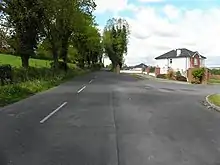Corranierna
Corranierna is a townland in the Parish of Tomregan, Barony of Tullyhaw, County Cavan, Ireland. (Disambiguation see also- Corranierna (Corlough) townland, County Cavan, Republic of Ireland.)

Etymology
The townland name is an anglicisation of either (1) Cor an Iarna, meaning 'The Hill of the Skein (of thread)’, which derived its name from the weavers who lived there. In the 1938 Dúchas Folklore Collection[1] there is an account of a flax mill in Corranierna, or (2) The local pronunciation however is 'Corr-Nern-Yah', which seems to indicate a different meaning: Cor na nAirchinneach, meaning 'The Hill of the Erenagh'. On the 1609 Ulster Plantation Baronial map it forms part of Mullaghduff townland.[2][3] On the Down Survey map of 1655 it was still part of Mullaghduff.[4] A 1666 grant includes it as Mullaghduffe alias Cloghane alias Cormerin.[5] A deed dated 2 May 1724 includes the townland as Mullaghduffe alias Cloghane alias Cormerin.[6] Corranierna remained as part of Mullaghduff until the beginning of the 19th century when the two townlands were separated.
Geography
It is bounded on the north & west by Annagh townland, on the east by Killywilly townland and on the south by Mullaghduff townland. Its chief geographical features are Annagh Lough, Killywilly Lough, two chalybeate wells and some drumlin hills reaching an altitude of 234 feet (71 m) above sea-level. The townland is traversed by the local L1505 road (known locally as the Yellow Road, so called because it was originally surfaced with yellow gravel and sandstone), Killywilly Lane, some minor lanes and the disused Cavan and Leitrim Railway. Corranierna covers an area of 180 statute acres, including 26 acres (110,000 m2) of water.
History
As it formed part of Mullaghduff, its history is the same as that townland until the beginning of the 19th century, when it was separated within the Montgomery estate.
George Montgomery died in 1841 and his estate went to his Enery cousins of Bawnboy. In 1856 they sold the estate to take advantage of its increased value owing to the opening of the Woodford Canal through the town in the same year. The estate, including Corranierna, was split up among different purchasers and maps & details of previous leases of the sold parts are still available.[7]
The Tithe Applotment Books for 1827 list the following tithepayers in the townland-Garvey, Fitzpatrick, Reilly, McCormick, Grimes.[8]
In 1829 a Sunday school was kept in the townland, funded by the Hibernian Sunday School Society.[9]
The 1836 Ordnance Survey Namebooks describe it as- Soil white gravelly clay of middling quality. About 45 acres of bog and 23 acres of water.
The Corranierna Valuation Office books are available for February 1840.[10][11]
Griffith's Valuation of 1857 lists the landlord of the townland as the Roe Estate & the tenants as Fitzpatrick, Roe, Reilly, Sheridan, Lomus, Cochrane, McGarvey, Smith, Kennedy, McCormack, Cassidy and Graham.[12]
Census
| Year | Population | Males | Females | Total Houses | Uninhabited |
|---|---|---|---|---|---|
| 1841 | 160 | 79 | 81 | 29 | 0 |
| 1851 | 113 | 58 | 55 | 23 | 0 |
| 1861 | 88 | 48 | 40 | 22 | 0 |
| 1871 | 86 | 49 | 37 | 21 | 0 |
| 1881 | 76 | 42 | 34 | 23 | 0 |
| 1891 | 70 | 36 | 34 | 20 | 0 |
A rare surviving page from the 1851 Census of Ireland lists the household of Michael Reilly of Corranierna.[13]
In the 1901 census of Ireland, there are sixteen families listed in the townland.[14]
In the 1911 census of Ireland, there are seventeen families listed in the townland.[15]
Antiquities
The only historic site in the townland is the disused Cavan and Leitrim Railway.
References
- "Ballyconnell (B.) | The Schools' Collection". dúchas.ie.
- "4.25. The Baronie of Tollagh Aghe".
- "The Baronie of Tollagh Aghe". 14 May 2018 – via Flickr.
- "Down Survey Maps | the Down Survey Project".
- "Commissioners of Public Records in Ireland : fourteenth and fifteenth reports with appendix, 1824-25". HMSO. 11 April 1825 – via Internet Archive.
- "Memorial extract — Registry of Deeds Index Project".
- http://www.cavanlibrary.ie/file/Local-Studies/Library-Scanned-Docs/Enery-Estate.pdf
- http://titheapplotmentbooks.nationalarchives.ie/search/tab/results.jsp?county=Fermanagh&parish=Tomregan&townland=Cowerna&search=Search Tithe Applotment Books 1827
- society, Hibernian Sunday school (11 April 1818). The report of the Hibernian Sunday school society for 1810 (-1837) – via Google Books.
- http://census.nationalarchives.ie/reels/vob/IRE_CENSUS_1821-51_007246947_00446.pdf
- http://census.nationalarchives.ie/reels/vob/IRE_CENSUS_1821-51_007246947_00447.pdf
- http://www.askaboutireland.ie/griffith-valuation/index.xml?action=doPlaceSearch&freetext=corranierna&countyname=CAVAN&baronyname=&unionname=&parishname=&Submit.x=30&Submit.y=14 Griffith’s Valuation 1857
- http://www.census.nationalarchives.ie/reels/c19/007246725/007246725_00056.pdf
- http://www.census.nationalarchives.ie/pages/1901/Cavan/Ballyconnell/Corranierna/ Census of Ireland 1901
- http://www.census.nationalarchives.ie/pages/1911/Cavan/Ballyconnell/Corranierna/ Census of Ireland 1911